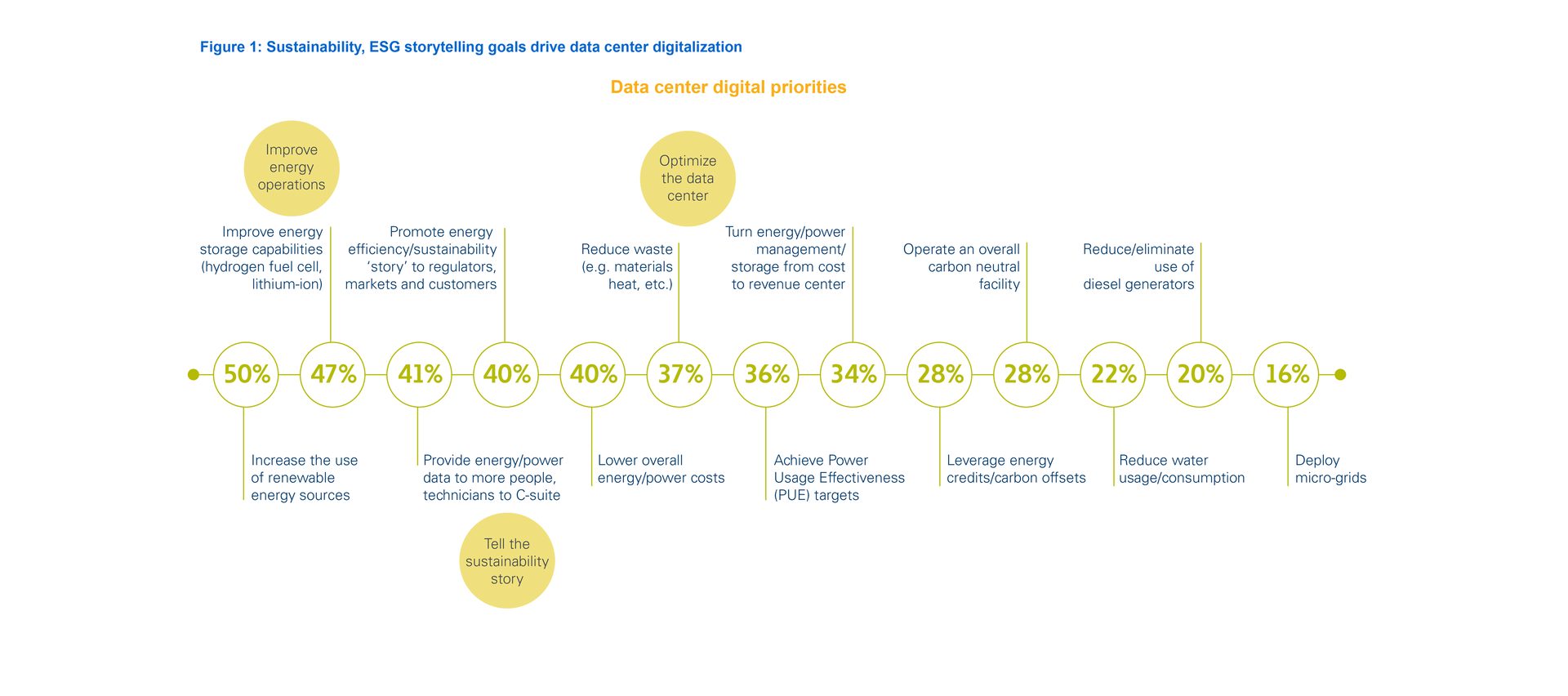Digitalization puts green data centers to work
Preparing for the energy transition
The enormous global appetite for online everything — connections, work, shopping, gaming, social media, and more — requires more data, more storage, and more data centers. How can the industry meet these growing data and energy needs sustainably and cost effectively?
A new study carried out by 451 Research/S&P Global Market Intelligence, The Intersection of Digital Transformation and the Energy Transition, examined the importance of factoring the energy transition into digital transformation planning. The research included 1,001 respondents (including 250 data center operators) who are involved in digital transformation efforts across four power-critical businesses — the center, utility, building, and industrial markets — in North America, Europe, and the Middle East.
The report shows that, because of the inherently digital nature of data centers, they are in a great position to manage and take advantage of the energy transition. However, establishing new energy business models is key, which means creating a business advantage by finding better ways to measure and manage energy usage to reduce costs. Data centers can also create new revenue sources from the power they generate. And better yet, they can do both.
Data center energy priorities require change
It’s clear from the study’s findings, data center operators must recognize that changes need to be made to ensure the increasingly digital world is also a sustainable one. Further, new energy business models are essential to improve upon how data centers view and manage power needs.
Unsurprisingly, the report showed this sector is largely driven by two imperatives: to deliver new and better services on one hand and update and optimize infrastructure on the other. Nearly half (47%) of respondents cited delivering new services and capabilities as a top data center challenge, along with meeting rising performance requirements. But those service challenges are matched by operational challenges, including optimizing energy/power consumption (38%) and meeting sustainability goals and metrics (37%).
There’s no question about it, these important energy considerations — power, cooling, and heat utilization — are already a components of optimized data centers. Moving forward, those needs will become even more important, as data centers proliferate and scale, their services become central to even more businesses — impacting site selection, construction, and operations.
The report also revealed some of the factors guiding the efficiency and sustainability efforts of data centers today. Among energy transition and sustainability goals, several stand out. Half of data center respondents cited the need to increase renewables; followed by improving energy storage (47%); providing power intelligence insights to more people — from technicians to the C-suite (41%); and promoting that story to regulators, markets, and customers (40%).
People's lives are becoming increasingly digitalized, and the energy required to achieve this is going to rise. To enjoy the benefits of a digital society and economy, there’s an energy price that must be paid.

A new study commissioned by Eaton revealed the strategies data centers are implementing today to improve energy operations, boost sustainability, and optimize operations.
Good grid citizens
It just takes one large spike in consumption or drop in production to destabilize the grid. For that reason, meeting energy goals requires more than simply consuming renewable energy. The challenge of accommodating high levels of renewables on the grid is faced by by everyone, especially mission critical facilities.
It’s essential to look at the relationship between data centers and the grid. The biggest risk and cost for data centers is grid failure. That means data center operators (and other large energy consumers) need to understand the energy coming in so they can use their facilities to optimize optimize grid performance. With the possibility to participate in grid services, data centers can reach their full potential as the vanguards of green energy through digitalization.
More than ever, data center designers have new parameters (and tools) to factor in. A data center campus can be like a mini power plant, covering its own load and having dispatchable power to help stabilize the grid. This is a new approach to data center design, build, and operation.

The results of the Intersection of Digital Transformation and the Energy Transition study showcase how digital technologies and new energy business models can be utilized to address the majority of surveyed data center priorities.
Digitalization is essential
Specific services that data centers can provide to the grid vary from energy generation and export to storage and frequency containment. The two main services operators can get on board with are frequency containment (active power reserves that are automatically controlled based on deviations in grid frequency), and/or dispatchable power (sources of electricity that can be programmed on demand at the request of grid operators.
Digital transformation provides the tools needed for the data center sector to economically support grid-interactive and grid-friendly design and operation. Here’s how:
- Grid-interactive UPS technology enables frequency containment services — The UPS has long been a critical safeguard against potentially damaging power anomalies, as well as vital battery backup to ensure business continuity during an unexpected power outage. Now, grid-interactive UPS technology can also support frequency containment. These services can also be achieved through small modifications to existing infrastructure and via power aggregators.
- Grid-interactive storage and UPSs support dispatchable power — Providing dispatchable power can be economically enabled when you’re ready to move away from diesel gensets for emergency power supplies. Through enhanced UPS infrastructure with extended battery systems, energy storage systems, fuel cells, or other modern and more sustainable forms of back-up power, you can be well positioned to provide dispatchable power to the grid.
- Clear visibility into complex energy flows in real time is a must-have — To facilitate sustainable changes, facilities need sophisticated modeling of the entire data center environment, pulling data from all essential assets within your facility. Consolidating data center infrastructure management (DCIM) and electrical power management system (EPMS) into one digital platform provides clear visibility and insights into critical functions and operational datasets to increase levels of system control and automation.
More than ever, data center power systems can do so much more than support reliable power. Digital solutions and electrical infrastructure are delivering sophisticated data analytics, control, and new energy management capabilities. This means data centers can be a vital partner in the energy transition — creating new possibilities for green data centers and a green grid — through the process of embracing digital change to deliver new and better services.

Cirián Forde
Cirián Forde is data center and IT market segment lead for Eaton’s Electrical Sector, EMEA.
Lead Image credit: Eaton
